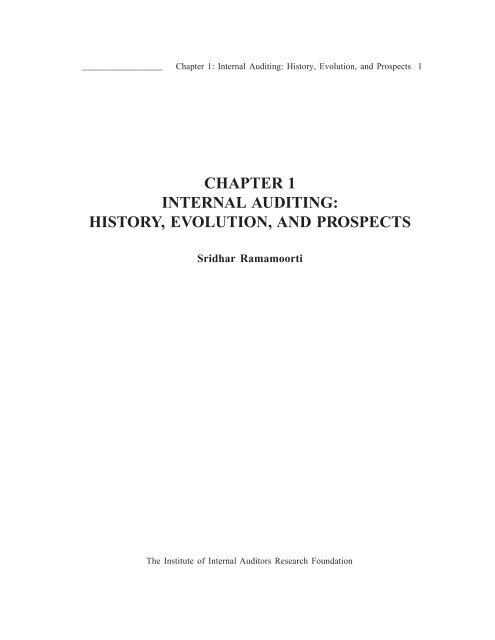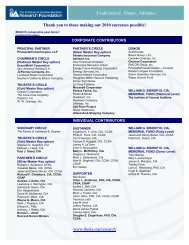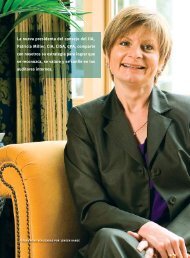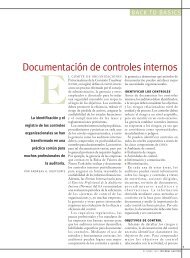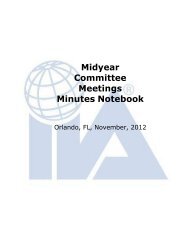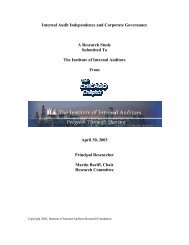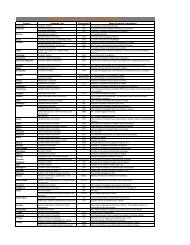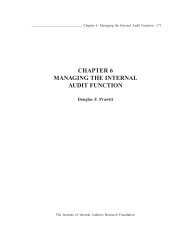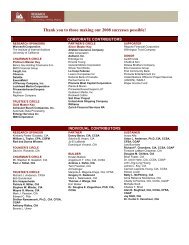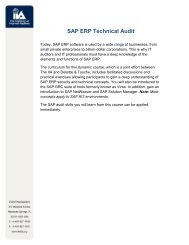Chapter 1.pmd - The Institute of Internal Auditors
Chapter 1.pmd - The Institute of Internal Auditors
Chapter 1.pmd - The Institute of Internal Auditors
Create successful ePaper yourself
Turn your PDF publications into a flip-book with our unique Google optimized e-Paper software.
__________________ <strong>Chapter</strong> 1: <strong>Internal</strong> Auditing: History, Evolution, and Prospects 1<br />
CHAPTER 1<br />
INTERNAL AUDITING:<br />
HISTORY, EVOLUTION, AND PROSPECTS<br />
Sridhar Ramamoorti<br />
<strong>The</strong> <strong>Institute</strong> <strong>of</strong> <strong>Internal</strong> <strong>Auditors</strong> Research Foundation
Disclosure<br />
Copyright © 2003 by <strong>The</strong> <strong>Institute</strong> <strong>of</strong> <strong>Internal</strong> <strong>Auditors</strong>, 247 Maitland Avenue, Altamonte Springs, Florida<br />
32701-4201. All rights reserved. Printed in the United States <strong>of</strong> America. No part <strong>of</strong> this publication may be<br />
reproduced, stored in a retrieval system, or transmitted in any form by any means — electronic, mechanical,<br />
photocopying, recording, or otherwise — without prior written permission <strong>of</strong> the publisher.<br />
<strong>The</strong> IIA publishes this document for informational and educational purposes. This document is intended<br />
to provide information, but is not a substitute for legal or accounting advice. <strong>The</strong> IIA does not provide such<br />
advice and makes no warranty as to any legal or accounting results through its publication <strong>of</strong> this document.<br />
When legal or accounting issues arise, pr<strong>of</strong>essional assistance should be sought and retained.<br />
<strong>The</strong> Pr<strong>of</strong>essional Practices Framework for <strong>Internal</strong> Auditing (PPF) was designed by <strong>The</strong> IIA Board <strong>of</strong> Directors’<br />
Guidance Task Force to appropriately organize the full range <strong>of</strong> existing and developing practice guidance<br />
for the pr<strong>of</strong>ession. Based on the definition <strong>of</strong> internal auditing, the PPF comprises Ethics and Standards,<br />
Practice Advisories, and Development and Practice Aids, and paves the way to world-class internal auditing.<br />
This guidance fits into the Framework under the heading Development and Practice Aids.<br />
ISBN 0-89413-498-1<br />
02404 01/03<br />
First Printing
2 Research Opportunities in <strong>Internal</strong> Auditing _________________________________<br />
I. Background<br />
<strong>The</strong> establishment, growth, and evolution <strong>of</strong> the contemporary internal auditing pr<strong>of</strong>ession<br />
is closely intertwined with the history <strong>of</strong> <strong>The</strong> <strong>Institute</strong> <strong>of</strong> <strong>Internal</strong> <strong>Auditors</strong> (IIA), an<br />
organization founded in the United States in 1941. In the recently released edition <strong>of</strong> 60<br />
Years <strong>of</strong> Progress Through Sharing, chronicling the history <strong>of</strong> <strong>The</strong> IIA, internal auditing<br />
historian Dale L. Flesher notes:<br />
“<strong>The</strong> IIA’s 60-year history is illustrious and each <strong>of</strong> the highlights featured in this 10year<br />
narration [supplementing the 50-year history <strong>of</strong> <strong>The</strong> IIA] have contributed to<br />
the organization that <strong>The</strong> IIA is today:<br />
• <strong>The</strong> primary international pr<strong>of</strong>essional association dedicated to the promotion<br />
and development <strong>of</strong> the practice <strong>of</strong> internal auditing.<br />
• <strong>The</strong> recognized authority, chief educator, and acknowledged leader in standards,<br />
certification, research, and technological guidance for the pr<strong>of</strong>ession worldwide.<br />
• Global headquarters for 76,400 members in 141 countries.” (Flesher & McIntosh,<br />
2002, ix)<br />
Considering <strong>The</strong> IIA’s rather humble origins — a small band <strong>of</strong> 24 charter members<br />
who held the inaugural IIA meeting in New York City 1 on December 9, 1941 — this<br />
worldwide expansion, continuing relevance, and increasing influence and recognition<br />
<strong>of</strong> <strong>The</strong> IIA and the internal auditing pr<strong>of</strong>ession over the last 60 years constitutes<br />
remarkable growth and progress. Indeed, the internal auditing pr<strong>of</strong>ession certainly<br />
appears poised for continued dynamic growth and promises to become “a pr<strong>of</strong>ession<br />
for the 21 st century.” 2<br />
II. <strong>Internal</strong> Auditing: An Historical Perspective<br />
<strong>The</strong> demand for both external and internal auditing is sourced in the need to have some<br />
means <strong>of</strong> independent verification to reduce record-keeping errors, asset misappropriation,<br />
and fraud within business and nonbusiness organizations. <strong>The</strong> roots <strong>of</strong> auditing, in general,<br />
are intuitively described by accounting historian Richard Brown (1905, quoted in Mautz &<br />
Sharaf, 1961) as follows:<br />
“<strong>The</strong> origin <strong>of</strong> auditing goes back to times scarcely less remote than that <strong>of</strong><br />
accounting…Whenever the advance <strong>of</strong> civilization brought about the necessity <strong>of</strong><br />
one man being intrusted to some extent with the property <strong>of</strong> another, the advisability<br />
<strong>of</strong> some kind <strong>of</strong> check upon the fidelity <strong>of</strong> the former would become apparent.”<br />
<strong>The</strong> <strong>Institute</strong> <strong>of</strong> <strong>Internal</strong> <strong>Auditors</strong> Research Foundation
__________________ <strong>Chapter</strong> 1: <strong>Internal</strong> Auditing: History, Evolution, and Prospects 3<br />
As far back as 4000 B.C., historians believe, formal record-keeping systems were first<br />
instituted by organized businesses and governments in the Near East to allay their concerns<br />
about correctly accounting for receipts and disbursements and collecting taxes. Similar<br />
developments occurred with respect to the Zhao dynasty in China (1122-256 B.C.). <strong>The</strong><br />
need for and indications <strong>of</strong> audits can be traced back to public finance systems in Babylonia,<br />
Greece, the Roman Empire, the City States <strong>of</strong> Italy, etc., all <strong>of</strong> which developed a detailed<br />
system <strong>of</strong> checks and counterchecks. Specifically, these governments were worried about<br />
incompetent <strong>of</strong>ficials prone to making bookkeeping errors and inaccuracies as well as corrupt<br />
<strong>of</strong>ficials who were motivated to perpetrate fraud whenever the opportunity arose. Even the<br />
Bible (referring to the period between 1800 B.C. and A.D. 95) explains the basic rationale<br />
for instituting controls rather straightforwardly: “…if employees have an opportunity to<br />
steal they may take advantage <strong>of</strong> it.” <strong>The</strong> Bible also contains examples <strong>of</strong> internal controls<br />
such as the dangers <strong>of</strong> dual custody <strong>of</strong> assets, the need for competent and honest employees,<br />
restricted access, and segregation <strong>of</strong> duties (O’Reilly et al., 1998). Historically then, the<br />
emergence <strong>of</strong> double-entry bookkeeping in circa 1494 A.D. can be directly traced to the<br />
critical need for exercising stewardship and control. Throughout European history, for instance,<br />
fraud cases — such as the South Sea bubble <strong>of</strong> the 18th century, and the tulip scandal —<br />
provided the justification for exercising more control over managers.<br />
Within a span <strong>of</strong> a couple <strong>of</strong> centuries, the European systems <strong>of</strong> bookkeeping and auditing<br />
were introduced into the United States. As business activities grew in size, scope, and<br />
complexity, a critical need for a separate internal assurance function that would verify the<br />
(accounting) information used for decision-making by management emerged. Management<br />
needed some means <strong>of</strong> evaluating not only the efficiency <strong>of</strong> work performed for the business<br />
but also the honesty <strong>of</strong> its employees. Around the turn <strong>of</strong> the 20 th century, the establishment<br />
<strong>of</strong> a formal internal audit function to which these responsibilities could be delegated was<br />
seen as the logical answer. In due course, the internal audit function became responsible for<br />
“careful collection and interpretive reporting <strong>of</strong> selected business facts” to enable management<br />
to keep track <strong>of</strong> significant business developments, activities, and results from diverse and<br />
voluminous transactions (Mautz, 1964). Companies in the railroad, 3 defense, and retail<br />
industries had long recognized the value <strong>of</strong> internal audit services, going far beyond financial<br />
statement auditing and devoted to furnishing reliable operating reports containing nonfinancial<br />
data such as “quantities <strong>of</strong> parts in short supply, adherence to schedules, and quality <strong>of</strong> the<br />
product” (Whittington & Pany, 1998). Similarly, the U.S. General Accounting Office (GAO)<br />
and numerous State <strong>Auditors</strong>’ Offices, for instance, the State <strong>of</strong> Ohio <strong>Auditors</strong>’ Office, have<br />
traditionally employed large numbers <strong>of</strong> internal auditors.<br />
In sum, the collective effect <strong>of</strong> growing transaction complexity and volume, the owner/<br />
manager’s (“principals”) remoteness from the source <strong>of</strong> transactions and potential bias <strong>of</strong><br />
<strong>The</strong> <strong>Institute</strong> <strong>of</strong> <strong>Internal</strong> <strong>Auditors</strong> Research Foundation
4 Research Opportunities in <strong>Internal</strong> Auditing _________________________________<br />
reporting parties (“agents”), technical (accounting) expertise required to review and<br />
summarize business activities in a meaningful way, need for organizational status to ensure<br />
independence and objectivity, as well as the procedural discipline necessary for being the<br />
“eyes and ears” <strong>of</strong> management all contributed to the creation <strong>of</strong> an internal audit department<br />
within business organizations. Starting as an internal business function primarily focused on<br />
protection against payroll fraud, loss <strong>of</strong> cash, and other assets, internal audit’s scope was<br />
quickly extended to the verification <strong>of</strong> almost all financial transactions, and still later, gradually<br />
moved from an “audit for management” emphasis to an “audit <strong>of</strong> management” approach 4<br />
(Reeve, 1986).<br />
<strong>The</strong> critical importance and relevance <strong>of</strong> internal auditing to business, as well as the raison<br />
d’etre for the establishment <strong>of</strong> <strong>The</strong> <strong>Institute</strong> <strong>of</strong> <strong>Internal</strong> <strong>Auditors</strong> in the United States, can best<br />
be gauged from the following visionary and prescient remarks by two <strong>of</strong> <strong>The</strong> IIA’s charter<br />
members (quoted in Flesher, 1996, pp. 1, 3):<br />
“Necessity created internal auditing and is making it an integral part <strong>of</strong> modern<br />
business. No large business can escape it. If they haven’t got it now, they will have<br />
to have it sooner or later, and, if events keep developing as they do at present, they<br />
will have to have it sooner.” (Arthur E. Hald, 1944)<br />
“<strong>The</strong> <strong>Institute</strong> is the outgrowth <strong>of</strong> the belief on the part <strong>of</strong> internal auditors that an<br />
organization was needed in the structure <strong>of</strong> American business to develop the true<br />
pr<strong>of</strong>essional status <strong>of</strong> internal auditing…Although its roots are in accountancy, its<br />
key purpose lies in the area <strong>of</strong> management control. It comprises a complete<br />
intracompany financial and operational review.” (Robert B. Milne, 1945)<br />
Nevertheless, in the early years after <strong>The</strong> IIA was established, internal auditing was still<br />
perceived as a closely related extension <strong>of</strong> the work <strong>of</strong> external auditors — they were<br />
frequently called upon to assist external auditors in financial statement reviews or perform<br />
accounting-related functions such as bank reconciliations. <strong>Internal</strong> auditors were seen to be<br />
playing a fairly modest role within organizations and had only a “limited responsibility in<br />
the total managerial spectrum” (Moeller & Witt, 1999).<br />
Almost two decades after the founding <strong>of</strong> <strong>The</strong> IIA, the following definition <strong>of</strong> internal auditing,<br />
laying the ground for an “operational auditing” orientation, 5 was presented by Brink and<br />
Cashin (1958):<br />
“<strong>Internal</strong> auditing thus emerges as a special segment <strong>of</strong> the broad field <strong>of</strong> accounting,<br />
utilizing the basic techniques and method <strong>of</strong> auditing. <strong>The</strong> fact that the public<br />
<strong>The</strong> <strong>Institute</strong> <strong>of</strong> <strong>Internal</strong> <strong>Auditors</strong> Research Foundation
__________________ <strong>Chapter</strong> 1: <strong>Internal</strong> Auditing: History, Evolution, and Prospects 5<br />
accountant and the internal auditor use many <strong>of</strong> the same techniques <strong>of</strong>ten leads to a<br />
mistaken assumption that there is little difference in the work or in ultimate objectives.<br />
<strong>The</strong> internal auditor, like any auditor, is concerned with the investigation <strong>of</strong> the validity<br />
<strong>of</strong> representations, but in his case the representations with which he is concerned<br />
cover a much wider range and have to do with many matters where the relationship<br />
to the accounts is <strong>of</strong>ten somewhat remote. In addition, the internal auditor, being a<br />
company man, has a more vital interest in all types <strong>of</strong> company operations and is<br />
quite naturally more deeply interested in helping to make those operations as pr<strong>of</strong>itable<br />
as possible. Thus, to a greater extent, management services comes to influence his<br />
thinking and general approach.”<br />
Soon thereafter, the National Industrial Conference Board underscored the importance <strong>of</strong><br />
internal auditing thus (Walsh, 1963):<br />
“<strong>The</strong> widening gap between management and action has made it necessary to develop<br />
a series <strong>of</strong> controls by means <strong>of</strong> which the business may be administered efficiently.<br />
<strong>The</strong> internal auditor perfects and completes each <strong>of</strong> these activities by providing onthe-scene<br />
appraisal <strong>of</strong> each form <strong>of</strong> control. <strong>The</strong>re is no known substitute for this<br />
activity.”<br />
With respect to pr<strong>of</strong>essional standards and pr<strong>of</strong>essional responsibilities, the two most influential<br />
individuals in <strong>The</strong> IIA’s history were arguably Victor Z. Brink and Lawrence B. Sawyer, 6<br />
respectively. Already introduced as a pioneering figure in 20 th century internal auditing,<br />
Victor Z. Brink, as <strong>The</strong> IIA’s first research director, was instrumental in getting <strong>The</strong> IIA’s<br />
Statement <strong>of</strong> Responsibilities <strong>of</strong> the <strong>Internal</strong> Auditor issued in 1947. <strong>The</strong> Statement <strong>of</strong><br />
Responsibilities <strong>of</strong> the <strong>Internal</strong> Auditor clarified that while internal auditing primarily dealt<br />
with accounting and financial matters, matters <strong>of</strong> an operating nature also lay within its<br />
scope <strong>of</strong> activities. By 1957, the Statement <strong>of</strong> Responsibilities <strong>of</strong> <strong>Internal</strong> Auditing had been<br />
considerably broadened to include numerous services to management, such as:<br />
1. Reviewing and appraising the soundness, adequacy, and application <strong>of</strong> accounting,<br />
financial, and operating controls.<br />
2. Ascertaining the extent <strong>of</strong> compliance with established policies, plans, and<br />
procedures.<br />
3. Ascertaining the extent to which company assets are accounted for, and safeguarded<br />
from, losses <strong>of</strong> all kinds.<br />
4. Ascertaining the reliability <strong>of</strong> accounting and other data developed within the<br />
organization.<br />
5. Appraising the quality <strong>of</strong> performance in carrying out assigned responsibilities.<br />
<strong>The</strong> <strong>Institute</strong> <strong>of</strong> <strong>Internal</strong> <strong>Auditors</strong> Research Foundation
6 Research Opportunities in <strong>Internal</strong> Auditing _________________________________<br />
Subsequently, in 1971, as chairman <strong>of</strong> the Research Committee, Lawrence Sawyer assumed<br />
the task <strong>of</strong> successfully revising the Statement <strong>of</strong> Responsibilities. <strong>The</strong> Statement <strong>of</strong><br />
Responsibilities underwent further revisions in 1976, 1981, and 1990 to reflect the continuing<br />
and rapid evolution <strong>of</strong> the internal auditing pr<strong>of</strong>ession.<br />
In 1978, <strong>The</strong> IIA formally approved the Standards for the Pr<strong>of</strong>essional Practice <strong>of</strong> <strong>Internal</strong><br />
Auditing (Standards), which had the following purposes:<br />
“1. Assist in communicating to others the role, scope, performance, and objectives<br />
<strong>of</strong> internal auditing.<br />
2. Unify internal auditing throughout the world.<br />
3. Encourage improved internal auditing.<br />
4. Establish basis for consistent measurement <strong>of</strong> internal auditing operations.<br />
5. Provide a vehicle by which internal auditing can be fully recognized as a<br />
pr<strong>of</strong>ession.”<br />
<strong>The</strong> Standards contained the following definition and objective <strong>of</strong> internal auditing:<br />
“<strong>Internal</strong> auditing is an independent appraisal activity established within an<br />
organization as a service to the organization. It is a control which functions by<br />
examining and evaluating the adequacy and effectiveness <strong>of</strong> other controls. <strong>The</strong><br />
objective <strong>of</strong> internal auditing is to assist members <strong>of</strong> the organization in the effective<br />
discharge <strong>of</strong> their responsibilities. To this end, internal auditing furnishes them with<br />
analyses, appraisals, recommendations, counsel, and information concerning the<br />
activities reviewed. <strong>The</strong> audit objective includes promoting effective control at<br />
reasonable cost.”<br />
<strong>The</strong> Standards also laid out the criteria, using which, internal audit department operations<br />
should be evaluated and measured. <strong>The</strong>y covered various aspects <strong>of</strong> internal auditing within<br />
organizations such as independence, pr<strong>of</strong>essional pr<strong>of</strong>iciency, scope <strong>of</strong> work, performance<br />
<strong>of</strong> audit work, and management <strong>of</strong> the internal audit department. Standards interpretations<br />
were enshrined in Statements on <strong>Internal</strong> Auditing Standards (SIAS); some examples <strong>of</strong><br />
these were specific SIAS focusing on control concepts, risk assessment, preventing and<br />
investigating fraud, relationships with independent auditors, communication with board <strong>of</strong><br />
directors, assignment planning, and follow-up on audit findings.<br />
By this time, in terms <strong>of</strong> planning, fieldwork, and reporting, the basic steps in an operational<br />
audit had been sequenced as follows: perform a preliminary survey; develop the audit program;<br />
perform the fieldwork; prepare the working papers; develop a list <strong>of</strong>, and prioritize, audit<br />
<strong>The</strong> <strong>Institute</strong> <strong>of</strong> <strong>Internal</strong> <strong>Auditors</strong> Research Foundation
__________________ <strong>Chapter</strong> 1: <strong>Internal</strong> Auditing: History, Evolution, and Prospects 7<br />
findings; discuss findings with the auditee; and, finally, prepare and present the audit report.<br />
<strong>The</strong> Standards and the SIAS served as the measures <strong>of</strong> the quality <strong>of</strong> performance <strong>of</strong> internal<br />
audit work engagements.<br />
<strong>The</strong>re was no doubt that, by the late 1970s, the field <strong>of</strong> internal auditing had earned the right<br />
to be called a “full-fledged pr<strong>of</strong>ession,” even using James Carey’s (1969) seven, fairly<br />
stringent qualifying conditions for a “pr<strong>of</strong>ession.” Sometime after 1974, when the Certified<br />
<strong>Internal</strong> Auditor (CIA) exam was sponsored by <strong>The</strong> IIA, internal auditing had a sufficiently<br />
respectable pr<strong>of</strong>ile and merited being called an established pr<strong>of</strong>ession because: it had a<br />
body <strong>of</strong> specialized knowledge (common body <strong>of</strong> knowledge approved in 1972), a formal<br />
educational process (a minimum prescribed course <strong>of</strong> formal education), standards governing<br />
admission as a full member <strong>of</strong> <strong>The</strong> IIA (prescribed course <strong>of</strong> study, passing CIA exam,<br />
pr<strong>of</strong>essional experience requirements, and the Standards), a Code <strong>of</strong> Ethics (first approved<br />
in 1968), a recognized status indicated by a license or special designation (the CIA, or the<br />
MIIA 7 , recognized in several jurisdictions worldwide), a public interest in the work that the<br />
practitioners perform (perhaps more evident in the work performed by internal auditors in<br />
government, education, and nonpr<strong>of</strong>it organizations rather than in the private sector), and a<br />
recognition by pr<strong>of</strong>essionals <strong>of</strong> a social obligation (again, perhaps more evident in<br />
government, education, and nonpr<strong>of</strong>it organizations).<br />
For the internal audit function to raise its organizational stature, it was critical that it forge a<br />
strong relationship with “those charged with organizational governance,” and communicate<br />
directly to the audit committee. <strong>The</strong>re is much evidence today that such a reporting relationship<br />
is being widely viewed as a best practice in the most progressive corporations committed to<br />
enhancing governance structure and processes. In an early but landmark study on corporate<br />
audit committees, Mautz & Neumann (1977) stated:<br />
“For the most part the audit committee is viewed as a bridge between the board <strong>of</strong><br />
directors and the auditors…To fulfill their responsibilities to shareholders and the<br />
public at large, audit committee members have had to become more interested in,<br />
and better informed on, auditing matters. Management also has become aware <strong>of</strong> the<br />
necessity <strong>of</strong> protecting itself through adequate attention to internal controls and<br />
effective audits. Consequently, it has become more responsive to auditor suggestions<br />
and audit committee requests for information.”<br />
In similar vein, authors Brink & Witt (1982) noted that:<br />
“In most situations the internal auditing group has moved to very high levels in all<br />
operational areas and has established itself as a valued and respected part <strong>of</strong> the top<br />
<strong>The</strong> <strong>Institute</strong> <strong>of</strong> <strong>Internal</strong> <strong>Auditors</strong> Research Foundation
8 Research Opportunities in <strong>Internal</strong> Auditing _________________________________<br />
management effort. To an increasing extent also the internal auditor is serving the<br />
board <strong>of</strong> directors — usually via the audit committee <strong>of</strong> that board.”<br />
By 1993, the Statement <strong>of</strong> Responsibilities <strong>of</strong> <strong>Internal</strong> Auditing noted that “the scope <strong>of</strong><br />
internal auditing encompasses the examination and evaluation <strong>of</strong> the adequacy and<br />
effectiveness <strong>of</strong> the organization’s system <strong>of</strong> internal control and the quality <strong>of</strong> performance<br />
in carrying out assigned responsibilities.” At this time, the scope <strong>of</strong> internal auditing included:<br />
“1. Reviewing the reliability and integrity <strong>of</strong> financial and operating information<br />
and the means used to identify, measure, classify, and report such information.<br />
2. Reviewing the systems established to ensure compliance with those policies,<br />
plans, procedures, laws, and regulations that could have a significant impact on<br />
operations and reports, and determining whether the organization is in<br />
compliance.<br />
3. Reviewing the means <strong>of</strong> safeguarding assets and, as appropriate, verifying the<br />
existence <strong>of</strong> such assets.<br />
4. Appraising the economy and efficiency with which resources are employed.<br />
5. Reviewing operations or programs to ascertain whether results are consistent<br />
with established objectives and goals and whether the operations or programs<br />
are being carried out as planned.”<br />
It was well-understood by the early 1990s that internal auditors, depending on their particular<br />
organization’s needs and preferences, worked in several areas: compliance audits, audits <strong>of</strong><br />
transaction cycles, investigating fraud and other irregularities, evaluating operational efficiency,<br />
analysis, measurement and reporting <strong>of</strong> operational and organization-wide risks, and other<br />
assurance and consulting activities. <strong>The</strong>y performed a combination <strong>of</strong> financial reviews and<br />
audits, operational reviews and audits (sometimes called program audits, performance audits,<br />
comprehensive audits, and other similar descriptive labels), management audits, and<br />
compliance audits. In performing many <strong>of</strong> these activities, internal auditors made their<br />
approach risk-based and controls-focused. <strong>The</strong>y also made extensive use <strong>of</strong> sophisticated<br />
technology applications in carrying out audits.<br />
Gradually, internal auditors also began to exhibit “industry specialization” in terms <strong>of</strong> their<br />
domain knowledge <strong>of</strong> specific industries such as health care, oil, gas, and energy, defense,<br />
financial services, transportation, wholesale and retail, technology, telecommunications, media<br />
and entertainment, government and nonpr<strong>of</strong>its, education, etc. <strong>Internal</strong> audit staff began to<br />
come from diverse backgrounds, including a large proportion <strong>of</strong> non-accounting majors,<br />
and women gained prominence within the pr<strong>of</strong>ession. <strong>Internal</strong> auditors also became much<br />
more internationally oriented. In many cases, internal auditing became rather opportunistic,<br />
and internal auditors began to participate in and contribute to “special projects” on a<br />
<strong>The</strong> <strong>Institute</strong> <strong>of</strong> <strong>Internal</strong> <strong>Auditors</strong> Research Foundation
__________________ <strong>Chapter</strong> 1: <strong>Internal</strong> Auditing: History, Evolution, and Prospects 9<br />
contingency basis, whether performing the role <strong>of</strong> risk <strong>of</strong>ficers, ethics <strong>of</strong>ficers, or compliance<br />
<strong>of</strong>ficers, as the situation demanded.<br />
III. Contemporary Practice <strong>of</strong> <strong>Internal</strong> Auditing: Environmental<br />
Changes, New Roles and Responsibilities, New Definition<br />
As the internal auditing pr<strong>of</strong>ession became more firmly established, it responded quickly to<br />
new demands from significant regulatory and legislative mandates, as well as high-pr<strong>of</strong>ile<br />
(inter)national reports: the passage <strong>of</strong> the Foreign Corrupt Practices Act (1977), particularly<br />
its emphasis on internal controls; the issuance <strong>of</strong> the Report <strong>of</strong> the National Commission on<br />
Fraudulent Financial Reporting (Treadway Commission Report, 1987); the Report <strong>of</strong> the<br />
Committee <strong>of</strong> Sponsoring Organizations (COSO) <strong>of</strong> the Treadway Commission (COSO, 1992);<br />
as well as the subsequent internal control frameworks presented by the Cadbury Committee<br />
Report (Cadbury Report, UK); the Criteria <strong>of</strong> Control Committee (CoCo Report, Canada);<br />
and the King Committee (King Report, South Africa); the amendments to the U.S. Federal<br />
Sentencing Guidelines (1995); recent changes in the New York Stock Exchange rules<br />
regarding the structure and composition <strong>of</strong> the Board <strong>of</strong> Directors <strong>of</strong> listed companies as<br />
well as the requirement for all publicly listed companies to have an internal audit function; 8<br />
the newly passed Sarbanes-Oxley Act <strong>of</strong> 2002; and ongoing calls for better organizational<br />
governance.<br />
<strong>The</strong> business environment has experienced rapid and revolutionary change with far reaching<br />
consequences for organizations worldwide. Management responses to fierce global<br />
competition have included improved quality and risk management initiatives, reengineered<br />
structures and processes, and greater accountability — all needing more timely, reliable, and<br />
relevant information for decision-making. Organizations are also scrambling to put in place<br />
more effective governance structures and processes. In such a climate, it is no surprise that<br />
the internal audit function is viewed as the most qualified group <strong>of</strong> pr<strong>of</strong>essionals to help with<br />
such experimentation with improved governance as well as support key governance processes:<br />
for monitoring the controls over, and for evaluating the operational effectiveness <strong>of</strong>, these<br />
management strategies and initiatives. However, to take advantage <strong>of</strong> this tremendous surge<br />
in the demand for their services, not only do internal auditors need a considerably enhanced<br />
repertoire <strong>of</strong> skills, attributes, and competencies but they also need to commensurately raise<br />
their organizational status and pr<strong>of</strong>ile and align themselves appropriately within their<br />
respective organizations.<br />
<strong>The</strong> <strong>Institute</strong> <strong>of</strong> <strong>Internal</strong> <strong>Auditors</strong> Research Foundation
10 Research Opportunities in <strong>Internal</strong> Auditing _________________________________<br />
Ratliff & Reding (2002, p. xi) capture the expanded responsibilities and skill-set <strong>of</strong> the 21 st<br />
century auditor as follows:<br />
“<strong>Auditors</strong> <strong>of</strong> the 21 st century must be prepared to ‘audit’ virtually everything —<br />
operations (including control systems), performance, information and information<br />
systems, legal compliance, financial statements, fraud, environmental reporting and<br />
performance, and quality. <strong>Auditors</strong> must master:<br />
• Analytical and critical thinking skills.<br />
• An efficient method to gain an adequate understanding <strong>of</strong> any auditee —<br />
individual, organization, or system.<br />
• New concepts, principles, and techniques <strong>of</strong> internal control.<br />
• An awareness and understanding <strong>of</strong> risk and opportunity related to both the<br />
auditee and the auditors.<br />
• Development <strong>of</strong> general and specific audit objectives for any audit project.<br />
• Selection, collection (using a broad array <strong>of</strong> audit procedures), evaluation, and<br />
documentation <strong>of</strong> audit evidence, including the use <strong>of</strong> statistical and non-statistical<br />
induction.<br />
• Reporting audit results in a variety <strong>of</strong> formats to a variety <strong>of</strong> recipients.<br />
• Audit follow-up.<br />
• Pr<strong>of</strong>essional ethics.<br />
• Audit technology applicable across a variety <strong>of</strong> types <strong>of</strong> audit reports.<br />
In addition, auditors must understand the concepts <strong>of</strong> auditor independence and<br />
objectivity as these concepts relate to different types <strong>of</strong> audits by different types <strong>of</strong><br />
auditors. <strong>The</strong>y must fully understand cost and materiality implications <strong>of</strong> risk,<br />
opportunity, and audit evidence.”<br />
In similar vein, Moeller & Witt (1999, p. 14-15) list the following necessary personal attributes<br />
to be a successful internal auditor (in addition to technical and pr<strong>of</strong>essional qualifications,<br />
this is a formidable list): (1) basic fairness and integrity; (2) dedication to the organization’s<br />
interests; (3) reasonable humility; (4) pr<strong>of</strong>essional poise; (5) empathy; (6) role consistency;<br />
(7) curiosity; (8) critical attitude; (9) alertness; (10) persistence; (11) energy; (12) selfconfidence;<br />
(13) courage; and (14) ability to make sound judgments.<br />
<strong>The</strong> new roles, responsibilities, and attributes <strong>of</strong> the contemporary internal auditor envisaged<br />
by these authors constitute a tall order. It is to understand these elements better that <strong>The</strong> IIA<br />
Research Foundation sponsored the wide-ranging, three-volume Competency Framework<br />
for <strong>Internal</strong> Auditing (CFIA) study (Birkett et al., 1999). This globally conducted study<br />
clearly pointed out the need for internal auditors to possess a radically expanded set <strong>of</strong> skills<br />
<strong>The</strong> <strong>Institute</strong> <strong>of</strong> <strong>Internal</strong> <strong>Auditors</strong> Research Foundation
__________________ <strong>Chapter</strong> 1: <strong>Internal</strong> Auditing: History, Evolution, and Prospects 11<br />
and competencies to cope with massive change and complexity in both private and public<br />
sector operations. A Delphi study, conducted as part <strong>of</strong> the comprehensive CFIA study,<br />
concluded that in the context <strong>of</strong> burgeoning change and uncertainty, the internal audit function<br />
adds value by providing assurances to those charged with organizational governance that<br />
organizational risk exposures are well understood, being monitored, and under control. A<br />
further conclusion <strong>of</strong> the Delphi study was that internal audit activities in the future would<br />
most likely be conducted through flexible, and many times self-directed, work teams featuring<br />
varying mixes <strong>of</strong> internal auditing specialists, application specialists, and general<br />
organizational personnel.<br />
Another seminal IIA Research Foundation study by Rittenberg & Covaleski (1997) described<br />
and assessed the impact <strong>of</strong> the “outsourcing phenomenon” and made the following summary<br />
points for the rapidly evolving internal auditing pr<strong>of</strong>ession: (1) <strong>The</strong>re is a monumental change<br />
underway in the way in which auditing is being done; (2) <strong>Internal</strong> auditing work can be<br />
done by non-employees; (3) Audit independence is a problem, but outsourcing is not the<br />
“make or break” issue; (4) Existing internal auditing departments should act as if they were<br />
going to be “market tested”; and (5) <strong>The</strong> IIA should rethink its process for establishing<br />
standards and policies.<br />
In the late 1990s, partly as a result <strong>of</strong> insightful, IIA-sponsored research studies as well as<br />
numerous forward-thinking articles in <strong>The</strong> IIA’s flagship journal, <strong>Internal</strong> Auditor, <strong>The</strong> IIA<br />
recognized a fundamental need to formally reassess and evaluate the pr<strong>of</strong>ession’s governing<br />
principles, orientation, and knowledge base <strong>of</strong> competencies and skills. <strong>The</strong>re was a fourfold<br />
purpose behind <strong>The</strong> IIA’s strategic document “A Vision for the Future,” viz., enhance the<br />
economic value <strong>of</strong> internal auditing; ensure consistently high quality internal auditing;<br />
strengthen the pr<strong>of</strong>essional standing <strong>of</strong> internal auditing; and achieve broad market awareness<br />
<strong>of</strong> internal auditing (GTF Report, 1999). <strong>The</strong> Guidance Task Force carried out a comprehensive<br />
review <strong>of</strong> the existing pr<strong>of</strong>essional standards, the code <strong>of</strong> ethics, and even the definition <strong>of</strong><br />
internal auditing. <strong>The</strong>y concluded that the old terminology failed to “adequately reflect the<br />
evolution <strong>of</strong> practice [or] effectively promote the internal audit pr<strong>of</strong>ession in the competitive<br />
marketplace” (Krogstad, Ridley & Rittenberg, 1999). <strong>The</strong> new Pr<strong>of</strong>essional Practices<br />
Framework embraced the following purposes (GTF Report, 1999):<br />
“1. Provide a flexible framework for supporting and promoting a broad range <strong>of</strong><br />
value-adding internal auditing activities.<br />
2. Delineate basic principles that represent the practice <strong>of</strong> internal auditing as it<br />
should be throughout the world.<br />
3. Foster improved organizational processes and operations.<br />
4. Require a quality assurance mechanism to ensure compliance with the Standards.<br />
<strong>The</strong> <strong>Institute</strong> <strong>of</strong> <strong>Internal</strong> <strong>Auditors</strong> Research Foundation
12 Research Opportunities in <strong>Internal</strong> Auditing _________________________________<br />
5. Achieve “preferred provider” recognition in the marketplace based on worldwide<br />
reputation for high quality internal auditing services.”<br />
<strong>The</strong> new definition <strong>of</strong> internal auditing is designed to accommodate the pr<strong>of</strong>ession’s expanding<br />
role and responsibilities:<br />
“<strong>Internal</strong> auditing is an independent, objective assurance and consulting activity<br />
designed to add value and improve an organization’s operations. It helps an<br />
organization accomplish its objectives by bringing a systematic, disciplined approach<br />
to evaluate and improve the effectiveness <strong>of</strong> risk management, control, and<br />
governance processes.”<br />
Chapman & Anderson (2002) explain that this new definition <strong>of</strong> internal auditing presents a<br />
new image <strong>of</strong> the pr<strong>of</strong>ession in six significant ways:<br />
1. As an objective activity, not necessarily established within the organization, the<br />
revised definition permits internal auditing services to be provided by “outsiders,” in<br />
effect acknowledging that quality internal audit services can now be obtained through<br />
outsourcing.<br />
2. By emphasizing that the scope <strong>of</strong> internal auditing encompasses assurance and<br />
consulting activities, the new definition projects internal auditing as proactive and<br />
customer-focused, and concerned with key issues in control, risk management, and<br />
governance.<br />
3. By explicitly stating that internal auditing is designed to add value and improve an<br />
organization’s operations, the new definition underscores the significant contribution<br />
that internal auditing makes for any organization.<br />
4. By considering the whole organization, the new definition perceives internal<br />
auditing’s mandate much more broadly, charging it with helping the organization<br />
accomplish overall objectives.<br />
5. <strong>The</strong> new definition assumes that controls only exist to help the organization manage<br />
its risk and promote effective governance. Such a perspective considerably broadens<br />
the horizons <strong>of</strong> internal auditing and expands its working domain to include risk<br />
management, control, and governance processes.<br />
6. <strong>The</strong> new definition accepts that the internal auditing pr<strong>of</strong>ession’s legacy, consisting<br />
<strong>of</strong> its unique franchise in being a standards-based pr<strong>of</strong>ession, may well be its most<br />
<strong>The</strong> <strong>Institute</strong> <strong>of</strong> <strong>Internal</strong> <strong>Auditors</strong> Research Foundation
__________________ <strong>Chapter</strong> 1: <strong>Internal</strong> Auditing: History, Evolution, and Prospects 13<br />
enduring and valuable asset. Rigorous standards provide the basis for crafting a<br />
documented, disciplined, and systematic process that assures quality performance<br />
on internal audit engagements.<br />
<strong>The</strong> new definition <strong>of</strong> internal auditing is enshrined in a comprehensive Pr<strong>of</strong>essional Practices<br />
Framework (IIA, 2002a), a structural blueprint <strong>of</strong> how the body <strong>of</strong> knowledge in internal<br />
auditing and the applicable guidance fits together. <strong>The</strong> Pr<strong>of</strong>essional Practices Framework<br />
consists <strong>of</strong> three categories <strong>of</strong> guidance: Standards and Ethics 9 (mandatory guidance), Practice<br />
Advisories (strongly recommended), and Development & Practice Aids (helpful reference<br />
materials developed or endorsed by <strong>The</strong> IIA). <strong>The</strong> Framework organizes the full range <strong>of</strong><br />
guidance in a manner that is readily accessible and timely for internal audit practitioners. It<br />
is expected to be responsive to the needs <strong>of</strong> internal audit practitioners and grow more<br />
robust in the coming years. <strong>The</strong> IIA Standards and elements <strong>of</strong> the Pr<strong>of</strong>essional Practices<br />
Framework are available on the IIA’s Web site at <br />
It is evident from the preceding historical review and summary that internal auditing has<br />
evolved remarkably over the last 60 years and has gained an increasingly important role<br />
within organizations, whether in industry, government, or the nonpr<strong>of</strong>it sector. Alongside<br />
this development, the internal auditing function today accepts a broader responsibility toward<br />
the organization itself and its stakeholders. By <strong>of</strong>fering expanded assurance and consulting<br />
services to the organization, i.e., in particular to the audit committee <strong>of</strong> the board <strong>of</strong> directors<br />
as well as to executive management, the internal audit function effectively contributes to<br />
improved organizational governance. Furthermore, information assured by internal auditors<br />
enhances both internal and external decision-making, thereby improving the deployment,<br />
and the effective and efficient use <strong>of</strong> scarce organizational and economic resources.<br />
Based on an understanding <strong>of</strong> how contemporary organizations function and the relevant<br />
influences, the internal audit function and its activities will be discussed using myriad<br />
perspectives in the following chapters <strong>of</strong> the Research Opportunities in <strong>Internal</strong> Auditing<br />
monograph. <strong>The</strong>se perspectives will provide a richer and fuller understanding <strong>of</strong> the context<br />
<strong>of</strong> the internal auditing function and its activities in modern organizations and thus help<br />
generate the types <strong>of</strong> basic and applied research questions that are likely to be <strong>of</strong> serious and<br />
enduring interest to academics and practitioners.<br />
IV. Prospects for the <strong>Internal</strong> Auditing Pr<strong>of</strong>ession<br />
Contemporary organizations are increasingly information-dependent and knowledgeintensive,<br />
and engage in extremely specialized and sophisticated operations across industries<br />
and sectors globally. <strong>The</strong> development <strong>of</strong> new organizational forms in the information age,<br />
<strong>The</strong> <strong>Institute</strong> <strong>of</strong> <strong>Internal</strong> <strong>Auditors</strong> Research Foundation
14 Research Opportunities in <strong>Internal</strong> Auditing _________________________________<br />
with the forging <strong>of</strong> strategic alliances and the emergence <strong>of</strong> virtual organizations, has<br />
dramatically altered the purpose and functioning <strong>of</strong> organizations as well as the attendant<br />
needs for exercising control. 10 <strong>The</strong> controls landscape within organizations today is quite<br />
different from those existing in the industrial-era traditional organizations for most <strong>of</strong> the<br />
20 th century. In this radically changed business environment, the internal audit function has<br />
become a major support function for management, the audit committee, the board <strong>of</strong> directors,<br />
the external auditors, as well as key stakeholders. Properly conceived and implemented, the<br />
internal audit function can play a critical role in promoting and supporting effective<br />
organizational governance.<br />
As multinational enterprises have recognized an increasing array <strong>of</strong> risks facing the<br />
organization, it is no surprise that the demand for risk management pr<strong>of</strong>essionals has risen<br />
dramatically (cf. Bernstein, 1996). Any disciplined approach to growth and value creation<br />
assumes that the organization is managing all manner <strong>of</strong> significant and likely risks effectively.<br />
Risk can be considered both at the macro or portfolio level (enterprise-wide risk management)<br />
as well as the micro or departmental level. Risk management is frequently an area in which<br />
internal audit can contribute greatly by furnishing analyses and providing wise counsel to<br />
top management and the board <strong>of</strong> directors. <strong>The</strong> internal audit function also performs microlevel<br />
risk assessment for its own purposes to identify those areas which demand the greatest<br />
efforts on the part <strong>of</strong> the internal audit function and for achieving appropriate audit coverage<br />
<strong>of</strong> the audit universe over defined periods <strong>of</strong> time (Ramamoorti & Traver, 1998). <strong>Internal</strong><br />
auditors can play a significant “partnering” role with management in establishing and<br />
monitoring business processes for the assessment, measurement, and reporting <strong>of</strong> risks in<br />
general and in implementing enterprise risk management initiatives. Modern approaches to<br />
risk-based internal auditing allow for the assessment <strong>of</strong> risks and linking them to business<br />
objectives systematically (McNamee & Selim, 1998; Walker, Shenkir, & Barton, 2002;<br />
DeLoach, 2000). Indeed, the internal audit function can facilitate the processes by which<br />
business units “can develop high quality risk assessments,” and this can in turn be very<br />
useful to the internal audit function in planning its own work, primarily by enhancing the<br />
quality <strong>of</strong> decision-relevant information and minimizing duplication <strong>of</strong> effort (Walker et al.,<br />
2002).<br />
One <strong>of</strong> the key premises today in any organization is that the presence <strong>of</strong> a strong internal<br />
audit function can go a long way in supporting and promoting effective organizational<br />
governance. Much <strong>of</strong> organizational governance has to do with effective monitoring and<br />
oversight <strong>of</strong> risk management, and internal auditors, if perceived as “risk management<br />
experts,” can expect to play an immensely significant and high-pr<strong>of</strong>ile role within organizations<br />
in the coming decades. With the recent New York Stock Exchange requirement for listed<br />
companies to have an internal audit function, the pr<strong>of</strong>ile <strong>of</strong> the internal audit function has<br />
<strong>The</strong> <strong>Institute</strong> <strong>of</strong> <strong>Internal</strong> <strong>Auditors</strong> Research Foundation
__________________ <strong>Chapter</strong> 1: <strong>Internal</strong> Auditing: History, Evolution, and Prospects 15<br />
been raised considerably. By being given a seat at the table where high-level discussions <strong>of</strong><br />
organizational governance occur, the horizons for the pr<strong>of</strong>ession have been considerably<br />
expanded and its opportunities to add value have grown exponentially. However, the challenge<br />
remains for internal audit pr<strong>of</strong>essionals to develop a keen understanding <strong>of</strong> the value<br />
proposition they <strong>of</strong>fer and manage their perception and image both within and without<br />
organizations. Once the internal audit function gains the trust and confidence <strong>of</strong> those charged<br />
with governance, it can proceed to deliver outstanding performance and value using the<br />
combined wealth <strong>of</strong> knowledge and experience possessed by its personnel in control best<br />
practices, risk monitoring and management, and governance structures and processes.<br />
Specifically, with all <strong>of</strong> the Big Four pr<strong>of</strong>essional services firms demonstrating a strong<br />
interest in developing their internal audit co-sourcing practices, the internal audit pr<strong>of</strong>ession<br />
is poised for significant international impact. Such globalization <strong>of</strong> internal auditing activities<br />
and the attendant recognition <strong>of</strong> the value added by the internal audit function are indeed<br />
welcome trends.<br />
In conclusion, the 21 st century presents much promise and unprecedented growth<br />
opportunities for the internal auditing pr<strong>of</strong>ession. However, developments in practice must<br />
be carefully studied by interested academics so that a body <strong>of</strong> knowledge is systematically<br />
built up and transmitted to future generations <strong>of</strong> internal auditing pr<strong>of</strong>essionals. <strong>The</strong> extant<br />
body <strong>of</strong> knowledge should not only be critiqued and constantly refined to reflect the current<br />
state <strong>of</strong> the art, but should also encourage and stimulate, through research, leading edge<br />
thinking that so <strong>of</strong>ten produces innovations in practice. We believe that this report constitutes<br />
an excellent source to start the journey that will yield important insights into internal auditing<br />
research, practice, and education.<br />
V. Summary <strong>of</strong> Research Issues<br />
<strong>The</strong> historical overview <strong>of</strong> internal auditing and the contemporary expectations from, and<br />
roles and responsibilities <strong>of</strong>, the internal audit function within organizations suggests a variety<br />
<strong>of</strong> research questions for exploration and investigation.<br />
Appearing in the Appendix is a series <strong>of</strong> potential research questions organized under captions<br />
such as: historical/archival/policy-oriented research, contemporary practice: state <strong>of</strong> the art<br />
<strong>of</strong> internal auditing, theory/common body <strong>of</strong> knowledge/education, prospects, and<br />
miscellaneous. We hope that interested academics would benefit from careful study <strong>of</strong> the<br />
suggested research questions and the lines <strong>of</strong> inquiry that they open up for future research<br />
investigation. (Note: <strong>The</strong> list <strong>of</strong> research questions in the Appendix is intended to be merely<br />
illustrative and is by no means exhaustive).<br />
<strong>The</strong> <strong>Institute</strong> <strong>of</strong> <strong>Internal</strong> <strong>Auditors</strong> Research Foundation
16 Research Opportunities in <strong>Internal</strong> Auditing _________________________________<br />
VI. Appendix I: <strong>Chapter</strong> Research Questions<br />
Historical/Archival/Policy-Oriented Research<br />
• How can we develop a simultaneous and integrated understanding <strong>of</strong> the global<br />
historical development <strong>of</strong> the internal audit pr<strong>of</strong>ession? (i.e., this might require a<br />
comparative Geographic Time Tables <strong>of</strong> History approach)<br />
• How has the evolution and development <strong>of</strong> internal auditing differed across regions<br />
<strong>of</strong> the world? What has been the most common triggering event? (e.g., massive<br />
fraud and business scandals followed by legislation supporting internal auditing)<br />
• Would comparative historical research, for instance, on the public policy implications<br />
<strong>of</strong> prohibiting the joint supply <strong>of</strong> external and internal auditing by the same public<br />
accounting firm yield useful lessons?<br />
• Why does the status <strong>of</strong> the internal audit function frequently seem to be a direct<br />
consequence <strong>of</strong> organizational leadership (C-suite executives) attitudes toward and<br />
expectations from internal audit? Would historical case studies <strong>of</strong> the long-standing<br />
internal audit functions in companies like J.C. Penney and Ford Motor Company<br />
shed light on this?<br />
• Historically, why have developments in internal auditing typically lagged<br />
developments in external auditing? (e.g., because internal auditing has not been<br />
yoked with organizational governance in the past? Not seen directly to contribute to<br />
the public interest? Not mandated or legislated?) In this era <strong>of</strong> investor capitalism, is<br />
this going to change with the suddenly heightened pr<strong>of</strong>ile <strong>of</strong> the internal auditing<br />
pr<strong>of</strong>ession? Does the chief audit executive, in his or her new role, need directors &<br />
<strong>of</strong>ficers (D & O) liability insurance coverage?<br />
• How can we assess the impact <strong>of</strong> economic vs. cultural variables on the evolution <strong>of</strong><br />
the internal auditing pr<strong>of</strong>ession?<br />
• To what extent are internal auditor attitudes and posturing reminiscent <strong>of</strong> “patterns<br />
<strong>of</strong> behavior” (cultural process variations) versus “patterns for behavior” (variations<br />
in cultural ends or ideals) in organizations?<br />
<strong>The</strong> <strong>Institute</strong> <strong>of</strong> <strong>Internal</strong> <strong>Auditors</strong> Research Foundation
__________________ <strong>Chapter</strong> 1: <strong>Internal</strong> Auditing: History, Evolution, and Prospects 17<br />
Contemporary Practice: <strong>Internal</strong> Auditing, State <strong>of</strong> the Art<br />
• What are some common features <strong>of</strong> internal audit methodologies, approaches, and<br />
tools used by world-class organizations? Can we distill best practices from such “in<br />
search <strong>of</strong> excellence” studies?<br />
• What impact is industry specialization having on internal audit pr<strong>of</strong>essionals and on<br />
the internal audit function? What about the impact <strong>of</strong> technology and globalization?<br />
• Why have internal auditors become so “opportunistic” in taking on a series <strong>of</strong> special<br />
projects on a contingency basis?<br />
• How valuable is it to perform ex ante as well as ex post “event studies” <strong>of</strong> the<br />
promulgation <strong>of</strong> IIA standards? Have the Standards been effective in influencing<br />
practice? Do they serve as measures <strong>of</strong> the quality <strong>of</strong> performance <strong>of</strong> internal audit<br />
engagements?<br />
• How good is the alignment between organizational goals and the internal audit<br />
function’s objectives, especially when internal auditors also assume the role <strong>of</strong> change<br />
agents?<br />
<strong>The</strong>ory/Common Body <strong>of</strong> Knowledge/Education<br />
• What are the fundamental postulates <strong>of</strong> internal auditing? What are the epistemological<br />
foundations <strong>of</strong> internal auditing, including relevant concepts and constructs, i.e.,<br />
ways <strong>of</strong> knowing, quality and quantity <strong>of</strong> evidence, risk metrics, problems <strong>of</strong> fact<br />
and problems <strong>of</strong> value, justification, independence and objectivity, process and<br />
methodology, etc.? How and in what respects has internal auditing diverged from<br />
external auditing over the years? What is the “Philosophy <strong>of</strong> <strong>Internal</strong> Auditing”? (cf.<br />
Mautz & Sharaf, 1961, a theoretical approach)<br />
• Do we need a follow up to the Competency Framework for <strong>Internal</strong> Auditing (CFIA)<br />
study every five years or so? Should we regard internal auditing as an expanding<br />
pr<strong>of</strong>ession and take appropriate steps to examine its structure, scope, and content on<br />
a global basis and with sufficient frequency to keep the common body <strong>of</strong> knowledge<br />
current and relevant?<br />
<strong>The</strong> <strong>Institute</strong> <strong>of</strong> <strong>Internal</strong> <strong>Auditors</strong> Research Foundation
18 Research Opportunities in <strong>Internal</strong> Auditing _________________________________<br />
• How should internal auditing, a pragmatic field like surgery, be taught at the university<br />
level? How do we instill a “lifelong learning” orientation in those who wish to become<br />
internal auditing practitioners?<br />
• What does the exercise <strong>of</strong> pr<strong>of</strong>essional judgment mean in the context <strong>of</strong> internal<br />
auditing? How do we design mechanisms that effectively capture the experience<br />
and expertise <strong>of</strong> seasoned internal audit pr<strong>of</strong>essionals and help with expert-novice<br />
knowledge transfer?<br />
Prospects<br />
• How could we try to chart the future <strong>of</strong> internal auditing? To what extent would<br />
studying disparate trends in organizational governance, technology, globalization,<br />
business complexity, demographic trends, education, etc. help?<br />
• What might we find from a systematic Porter-type “Five Forces Analysis” for internal<br />
auditing to trace the development, current state, and future preparedness <strong>of</strong> the internal<br />
auditing pr<strong>of</strong>ession?<br />
Miscellaneous<br />
• How useful is it to look at internal auditing theory using a “systems perspective”?<br />
Can organizational studies that adopt a holistic, integrated view and consider internal<br />
auditing in the context <strong>of</strong> the entire organization provide useful insights?<br />
• Does the fact that the CIA is a global designation instill pride and esprit de corps in<br />
members? Does the fact that they belong to a global pr<strong>of</strong>ession motivate members to<br />
hold themselves out accordingly and exhibit greater pr<strong>of</strong>essionalism?<br />
<strong>The</strong> <strong>Institute</strong> <strong>of</strong> <strong>Internal</strong> <strong>Auditors</strong> Research Foundation
__________________ <strong>Chapter</strong> 1: <strong>Internal</strong> Auditing: History, Evolution, and Prospects 19<br />
Footnotes<br />
1 <strong>The</strong> inaugural New York City meeting location was no doubt because <strong>of</strong> the city’s flourishing<br />
commercial activity and significance, but also because two <strong>of</strong> the earliest doctoral dissertations<br />
on the then fledgling subject <strong>of</strong> internal auditing were written by distinguished academics,<br />
both trained at Columbia University, New York City. <strong>The</strong>se two pioneers <strong>of</strong> internal auditing<br />
— Dr. C. Aubrey Smith, later affiliated with the University <strong>of</strong> Texas at Austin, and Dr. Victor<br />
Z. Brink, later affiliated with Ford Motor Company and Columbia University — went on to<br />
write influential books on the subject, <strong>Internal</strong> Audit Control (Smith, 1933) and <strong>Internal</strong><br />
Auditing (Brink, 1941).<br />
2 Interestingly, “<strong>Internal</strong> Auditing: A Pr<strong>of</strong>ession for the 21 st Century” was the 1996-97 theme<br />
chosen by then IIA Chairman <strong>of</strong> the Board Anthony J. Ridley to describe his vision for the<br />
pr<strong>of</strong>ession during his year at the helm.<br />
3 In the United States, by the mid-19 th century, internal auditors were actively assisting external<br />
auditors in investigating internal frauds at railroad companies in New York and New Haven<br />
(Previts & Merino, 1998).<br />
4 However, this transition has frequently not occurred in many organizations; the primary<br />
stumbling block is best captured by the phrase: “the issue <strong>of</strong> serving two masters.” On the<br />
one hand, internal auditors are typically employed by the organization (management) and<br />
need the support and cooperation <strong>of</strong> executive management to perform their duties effectively;<br />
on the other hand, when internal auditors are asked by the organization’s audit committee <strong>of</strong><br />
the board <strong>of</strong> directors to critique management performance, they must answer fearlessly<br />
recognizing their ultimate allegiance to those charged with organizational governance, not<br />
management. This unhappy situation <strong>of</strong> reporting to two masters creates much friction and<br />
tension for internal auditors. Indeed, if delicate issues are not managed tactfully, the ensuing<br />
breakdown in communications and cooperation can lead to a compromise <strong>of</strong> the internal<br />
audit function’s independence and objectivity and/or a diminished organizational status for<br />
the internal audit function.<br />
5 In 1964, Bradford Cadmus published his seminal Operational Auditing Handbook. Earlier<br />
in 1947, he had been appointed <strong>The</strong> IIA’s first paid managing director (Flesher, 1996).<br />
6 Lawrence Sawyer is also well-known for having written the celebrated book, <strong>The</strong> Practice<br />
<strong>of</strong> Modern <strong>Internal</strong> Auditing, now carrying the eponymous title, Sawyer’s <strong>Internal</strong> Auditing<br />
(Sawyer & Dittenh<strong>of</strong>er, 1996, 4 th Ed.). Larry Sawyer passed away in September 2002, just<br />
as this chapter was being finalized.<br />
<strong>The</strong> <strong>Institute</strong> <strong>of</strong> <strong>Internal</strong> <strong>Auditors</strong> Research Foundation
20 Research Opportunities in <strong>Internal</strong> Auditing _________________________________<br />
7 MIIA = Member <strong>of</strong> the <strong>Institute</strong> <strong>of</strong> <strong>Internal</strong> <strong>Auditors</strong>, is a pr<strong>of</strong>essional designation still used<br />
in the UK.<br />
8 <strong>The</strong> NYSE requirement for all publicly listed companies to have an internal audit function<br />
is a watershed event in the continued evolution <strong>of</strong> internal auditing in the United States.<br />
Such a mandate reinforces the credibility and legitimacy <strong>of</strong> the internal audit function for<br />
large, well-managed companies.<br />
9 Mandatory guidance consists <strong>of</strong> core materials: the Code <strong>of</strong> Ethics and Standards for the<br />
Pr<strong>of</strong>essional Practice <strong>of</strong> <strong>Internal</strong> Auditing (Standards). <strong>The</strong> purpose <strong>of</strong> <strong>The</strong> <strong>Institute</strong>’s Code<br />
<strong>of</strong> Ethics is to promote an ethical culture in the pr<strong>of</strong>ession <strong>of</strong> internal auditing. <strong>The</strong> Standards<br />
are the criteria by which the operations <strong>of</strong> an internal audit department or function are evaluated<br />
or measured. <strong>The</strong>y are intended to represent the practice <strong>of</strong> internal auditing as it should be.<br />
Three sets <strong>of</strong> Standards have been issued: Attribute, Performance, and Implementation<br />
Standards. <strong>The</strong> Attribute Standards address the attributes <strong>of</strong> the organizations and individuals<br />
performing internal audit services. <strong>The</strong> Performance Standards describe the nature <strong>of</strong> internal<br />
audit services and provide quality criteria against which the performance <strong>of</strong> these services<br />
can be measured. <strong>The</strong> Attribute and Performance Standards apply to all internal audit services.<br />
<strong>The</strong> Implementation Standards expand upon the Attribute and Performance Standards,<br />
providing guidance applicable in specific types <strong>of</strong> engagements. <strong>The</strong>se standards ultimately<br />
may deal with industry-specific, regional, or specialty types <strong>of</strong> audit services (IIA, 2002a,<br />
2002b).<br />
10 One indicator <strong>of</strong> the sophistication and complexity <strong>of</strong> internal audit activities is the number<br />
<strong>of</strong> specialty certifications sponsored by <strong>The</strong> IIA, beyond the generic Certified <strong>Internal</strong> Auditor<br />
(CIA) designation: Certificate in Control Self-Assessment (CCSA), Certified Government<br />
Auditing Pr<strong>of</strong>essional (CGAP), and more recently, Certified Financial Services Auditor (CFSA).<br />
<strong>The</strong> <strong>Institute</strong> <strong>of</strong> <strong>Internal</strong> <strong>Auditors</strong> Research Foundation
__________________ <strong>Chapter</strong> 1: <strong>Internal</strong> Auditing: History, Evolution, and Prospects 21<br />
References<br />
Bernstein, P.L., Against the Gods — <strong>The</strong> Remarkable Story <strong>of</strong> Risk (New York: John Wiley &<br />
Sons, 1996).<br />
Birkett, W.P., M.R. Barbera, B.S. Leithhead, M. Lower, and P.J. Roebuck, Competency<br />
Framework for <strong>Internal</strong> Auditing (CFIA). Three volumes. (Altamonte Springs, FL: <strong>The</strong><br />
<strong>Institute</strong> <strong>of</strong> <strong>Internal</strong> <strong>Auditors</strong> Research Foundation, 1999).<br />
Brink, V.Z., and J.A. Cashin, <strong>Internal</strong> Auditing (New York: Ronald Press, 1958).<br />
Brink, V.Z., and H.N. Witt, Modern <strong>Internal</strong> Auditing (New York: John Wiley & Sons, Inc.,<br />
1982).<br />
Carey, J.L., <strong>The</strong> Rise <strong>of</strong> the Accounting Pr<strong>of</strong>ession: From Technician to Pr<strong>of</strong>essional (New<br />
York: American <strong>Institute</strong> <strong>of</strong> Certified Public Accountants, 1969).<br />
Chapman, C., and U. Anderson, Implementing the Pr<strong>of</strong>essional Practices Framework<br />
(Altamonte Springs, FL: <strong>The</strong> <strong>Institute</strong> <strong>of</strong> <strong>Internal</strong> <strong>Auditors</strong>, 2002).<br />
DeLoach, J.W., Enterprise-wide Risk Management: Strategies for Linking Risk and<br />
Opportunity (London, UK: Financial Times, 2000).<br />
Flesher, D.L., <strong>Internal</strong> Auditing: Standards and Practices (Altamonte Springs, FL: <strong>The</strong> <strong>Institute</strong><br />
<strong>of</strong> <strong>Internal</strong> <strong>Auditors</strong>, 1996).<br />
Flesher, D.L., and E.R. McIntosh, 60 Years <strong>of</strong> Progress Through Sharing. 10-Year Supplement<br />
to 50 Years <strong>of</strong> Progress Through Sharing, 1991-2001 (Altamonte Springs, FL: <strong>The</strong> <strong>Institute</strong><br />
<strong>of</strong> <strong>Internal</strong> <strong>Auditors</strong>, 2002).<br />
Krogstad, J., A.J. Ridley, and L.E. Rittenberg, “Where We’re Going,” <strong>Internal</strong> Auditor, Oct.<br />
1999, pp. 28-33.<br />
Mautz, R.K., Fundamentals <strong>of</strong> Auditing, 2 nd Ed. (New York: John Wiley & Sons, Inc., 1964).<br />
Mautz, R.K., and H.A. Sharaf, <strong>The</strong> Philosophy <strong>of</strong> Auditing (Sarasota, FL: American Accounting<br />
Association, 1961).<br />
<strong>The</strong> <strong>Institute</strong> <strong>of</strong> <strong>Internal</strong> <strong>Auditors</strong> Research Foundation
22 Research Opportunities in <strong>Internal</strong> Auditing _________________________________<br />
McNamee, D., and G.M. Selim, Risk Management: Changing the <strong>Internal</strong> Auditor’s Paradigm<br />
(Altamonte Springs, FL: <strong>The</strong> <strong>Institute</strong> <strong>of</strong> <strong>Internal</strong> <strong>Auditors</strong> Research Foundation, 1998).<br />
Moeller, R., and H.N. Witt, Brink’s Modern <strong>Internal</strong> Auditing, 5 th Ed. (New York: John Wiley<br />
& Sons, Inc., 1999).<br />
O’Reilly, V.M., P. McDonnell, B.N. Winograd, J.S. Gerson, and H.R. Jaenicke, Montgomery’s<br />
Auditing, 12 th Ed. (New York: John Wiley & Sons, 1998).<br />
Porter, M.E., Competitive Advantage: Creating and Sustaining Superior Performance (New<br />
York: Free Press, 1985).<br />
Porter, M.E., Competitive Strategy: Techniques for Analyzing Industries and Competitors:<br />
With a New Introduction (New York: Free Press, 1998).<br />
Previts, G.J., and B.D. Merino, A History <strong>of</strong> Accountancy in the United States: <strong>The</strong> Cultural<br />
Significance <strong>of</strong> Accounting (Columbus, OH: <strong>The</strong> Ohio State University Press, 1998).<br />
<strong>The</strong> Pr<strong>of</strong>essional Practices Framework (Altamonte Springs, FL: <strong>The</strong> <strong>Institute</strong> <strong>of</strong> <strong>Internal</strong><br />
<strong>Auditors</strong>, 2002a).<br />
Ramamoorti, S., and R.O. Traver, Using Neural Networks for Risk Assessment in <strong>Internal</strong><br />
Auditing: A Feasibility Study (Altamonte Springs: <strong>The</strong> <strong>Institute</strong> <strong>of</strong> <strong>Internal</strong> <strong>Auditors</strong><br />
Research Foundation, 1998).<br />
Ratliff, R.L., and K.F. Reding, Introduction to Auditing: Logic, Principles, and Techniques<br />
(Altamonte Springs, FL: <strong>The</strong> <strong>Institute</strong> <strong>of</strong> <strong>Internal</strong> <strong>Auditors</strong>, 2002).<br />
Reeve, John T., <strong>Internal</strong> Auditing, pp. 8-1 to 8-39. In Cashin, J.A., Neuwirth, P.D., and Levy,<br />
J.F. (eds.), Cashin’s Handbook for <strong>Auditors</strong>, 2 nd Ed. (Englewood Cliffs, NJ: Prentice<br />
Hall, 1986).<br />
Report <strong>of</strong> the Committee <strong>of</strong> Sponsoring Organizations (COSO) <strong>of</strong> the Treadway Commission:<br />
<strong>Internal</strong> Control – Integrated Framework (New York: American <strong>Institute</strong> <strong>of</strong> Certified<br />
Public Accountants, 1992).<br />
Report <strong>of</strong> the Guidance Task Force to <strong>The</strong> IIA’s Board <strong>of</strong> Directors — A Vision for the<br />
Future: Pr<strong>of</strong>essional Practices Framework for <strong>Internal</strong> Auditing (Altamonte Springs,<br />
FL: <strong>The</strong> <strong>Institute</strong> <strong>of</strong> <strong>Internal</strong> <strong>Auditors</strong>, 1999).<br />
<strong>The</strong> <strong>Institute</strong> <strong>of</strong> <strong>Internal</strong> <strong>Auditors</strong> Research Foundation
__________________ <strong>Chapter</strong> 1: <strong>Internal</strong> Auditing: History, Evolution, and Prospects 23<br />
Rittenberg, L.E., and M. Covaleski, <strong>The</strong> Outsourcing Dilemma: What’s Best for <strong>Internal</strong><br />
Auditing (Altamonte Springs, FL: <strong>The</strong> <strong>Institute</strong> <strong>of</strong> <strong>Internal</strong> <strong>Auditors</strong> Research Foundation,<br />
1997).<br />
Rittenberg, L.E., and B.J. Schwieger, Auditing Concepts for a Changing Environment, 2 nd<br />
Ed. (Fort Worth, TX: <strong>The</strong> Dryden Press, 1997).<br />
Sawyer, L.B., and M.A. Dittenh<strong>of</strong>er, Sawyer’s <strong>Internal</strong> Auditing: <strong>The</strong> Practice <strong>of</strong> Modern<br />
<strong>Internal</strong> Auditing, 4 th Ed. (Altamonte Springs, FL: <strong>The</strong> <strong>Institute</strong> <strong>of</strong> <strong>Internal</strong> <strong>Auditors</strong>,<br />
1996).<br />
Smith, C.A., <strong>Internal</strong> Audit Control (Austin, TX: University Cooperative Society, 1933).<br />
Standards for the Pr<strong>of</strong>essional Practice <strong>of</strong> <strong>Internal</strong> Auditing (Altamonte Springs, FL: <strong>The</strong><br />
<strong>Institute</strong> <strong>of</strong> <strong>Internal</strong> <strong>Auditors</strong>, 2002b) [Online] www.theiia.org.<br />
Tillinghast-Towers Perrin Study. Enterprise Risk Management: Trends and Emerging Practices<br />
(Altamonte Springs, FL: <strong>The</strong> <strong>Institute</strong> <strong>of</strong> <strong>Internal</strong> <strong>Auditors</strong> Research Foundation, 2001).<br />
Walker, P.L., W.G. Shenkir, and T.L. Barton, Enterprise Risk Management: Pulling it All<br />
Together (Altamonte Springs, FL: <strong>The</strong> <strong>Institute</strong> <strong>of</strong> <strong>Internal</strong> <strong>Auditors</strong> Research Foundation,<br />
2002).<br />
Walsh, Jr., F.J., <strong>Internal</strong> Auditing: Business Policy Study No. 111 (New York: National Industrial<br />
Conference Board, 1963).<br />
Whittington, O.R., and K. Pany, Principles <strong>of</strong> Auditing, 12 th Ed. (Boston, MA: Irwin McGraw<br />
Hill, 1998).<br />
Acknowledgments: I would like to thank Andy Bailey, Audrey Gramling, and especially<br />
Larry Rittenberg, for their insightful comments on the structure, scope, and presentation <strong>of</strong><br />
this opening ROIA chapter. I remain grateful to Betty McPhilimy, Flemming Ruud, Alan<br />
Siegfried, Richard Traver, as well as the May 2002 Chicago ROIA Conference participants<br />
for their feedback and comments on an earlier version <strong>of</strong> this chapter. I would also like to<br />
acknowledge Susan Lione’s assistance in promptly securing me the necessary reference<br />
materials.<br />
<strong>The</strong> <strong>Institute</strong> <strong>of</strong> <strong>Internal</strong> <strong>Auditors</strong> Research Foundation


